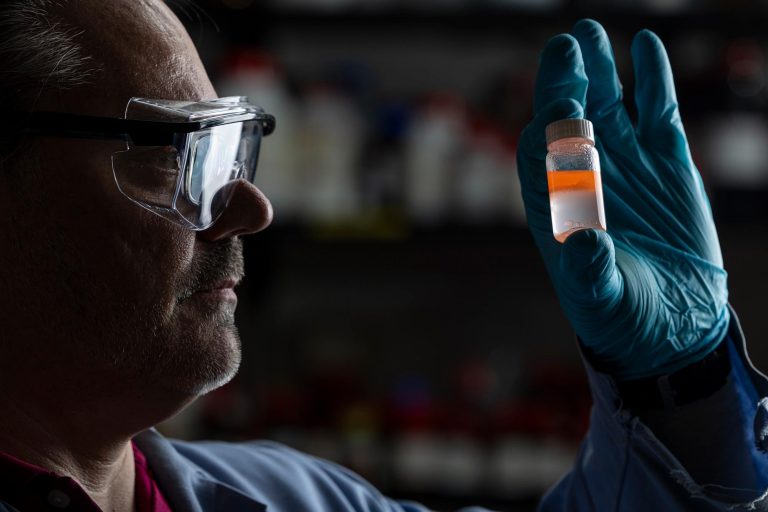“Our strategy is to use a small amount of a special solvent to absorb plastic particles from a large amount of water,” said Gary Baker, an associate professor in the University of Missouri Department of Chemistry. Photo by Sam O'Keefe/University of Missouri
A research team from the University of Missouri has devised a way to remove most of the nanoplastics from water using an environmentally friendly solvent that is suitable for both freshwater and saltwater.
Nanoplastics are the new enemy for human health: they are much smaller than the diameter of an average human hair and therefore invisible to the naked eye.
Nanoplastics have been linked to cardiovascular and respiratory disease in humans and continue to accumulate largely unnoticed in water bodies around the world. The challenge is to develop cost-effective solutions to remove nanoplastics while leaving clean water.
Now, researchers at the University of Missouri have developed a groundbreaking liquid-based solution that removes more than 98% of these tiny plastic particles from water. The method, detailed in a new study published in the journal ACS Applied Engineering Materials, promises to be a major advancement in water purification technology.
Gary Baker, an associate professor in the University of Missouri Department of Chemistry, looks at a bottle of a new liquid-based solution that removes more than 98% of tiny plastic particles from water. Photo by Sam O'Keefe/University of Missouri
“Nanoplastics can disrupt aquatic ecosystems and enter the food chain, posing a danger to both wildlife and humans,” said Piuni Ishtaweera, a recent graduate who led the research while earning her doctorate in nano and materials chemistry at the University of Missouri. “Simply put, we are developing better ways to remove contaminants such as nanoplastics from water.”
Innovative purification method
This new method, using a water-repellent solvent made from natural ingredients, not only offers a practical solution to the pressing problem of nanoplastic pollution, but also paves the way for further research and development into advanced water purification technologies.
When mixed with water and re-isolated, the solvent rises to the surface with the nanoplastics still in their molecular structure. Credit: Sam O'Keefe/University of Missouri
“Our strategy uses small amounts of designer solvents to absorb plastic particles from large volumes of water,” said Gary Baker, an associate professor in the University of Missouri Department of Chemistry and corresponding author of the study. “Currently, the capacity of these solvents is not well understood. In future studies, we aim to determine the maximum capacity of the solvents. Additionally, we will study ways to recycle the solvents so that they can be reused multiple times if needed.”
Scaling and Future Applications
Initially, the solvent floats on the surface of the water in the same way that oil floats on water. When it mixes with water and re-separates, the solvent returns to the surface with the nanoplastics still in its molecular structure.
In the lab, the researchers simply use a pipette to remove the nanoplastic-laden solvent, leaving behind clean, plastic-free water. Baker said that future work will involve scaling up the whole process so that it can be applied to larger bodies of water, such as lakes and eventually oceans.
This diagram outlines the two-stage extraction method. Credit: Gary Baker Implications and next steps
Ishtaweera, who now works for the U.S. Food and Drug Administration in St. Louis, noted that the new method works in both freshwater and saltwater.
“These solvents are made from safe, non-toxic ingredients and their ability to repel water prevents further contamination of water sources, making them a very sustainable solution,” she said. “From a scientific perspective, developing effective removal methods will spur innovation in filtration technologies, provide insight into the behavior of nanomaterials, and aid in the development of informed environmental policy.”
A team from the University of Missouri tested five different sizes of polystyrene-based nanoplastics, a type of plastic commonly used to make Styrofoam cups, and their results go beyond previous studies that have focused primarily on a single size of plastic particle.
Reference: “Extraction of Nanoplastics from Water with Hydrophobic Deep Eutectic Solvents,” Piyuni Ishtaweera, Colleen L. Ray, Wyland Filley, Garrett Cobb, Gary A. Baker, June 4, 2024, ACS Applied Engineering Materials.
DOI: 10.1021/acsaenm.4c00159

